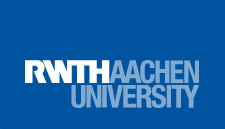Schlagwort: ‘Mastersarbeit’
Writing my Master Thesis in Trondheim
- Chemistry M. Sc.
- Norway, Trondheim
- Norges Teknisk-Naturvitenskapelige Universitet
- 07/2024 – 01/2025

Figure 1: Cross-country skiing on Finsevatnet in Finse, mid-January. ©Julia Wang
Preparations
People often ask for the reason I chose Norway: Initially, I planned to do an internship in Sweden and then return to Germany for my thesis. Unfortunately, I lost contact to my Swedish prof, and as time was running out, I finished all required internships in Germany. However, I struggled to find a suitable thesis topic, so I decided to write it externally, including universities from countries in Ireland and Scandinavia in my search. I wanted to improve my English skills and also experience a place full of nature I have never been to before. As the nature in Ireland, Sweden, Norway, and Finland is beautiful, I ultimately found that Norway was the best fit for me. It offered a fascinating language but still with the comfort to speak English anytime, stunning landscapes, beautiful nature, a vibrant student city, and an exciting thesis topic.
I came across the topic of my thesis by proactively reaching out to professors working in areas I found particularly intriguing. As a chemistry student, I was often dissatisfied with the specializations at my university, so learning that Norway has a strong focus on environmental chemistry caught my attention. After a response from a professor, we had a brief meeting where he introduced me to a project based within the Arctic Circle, combining environmental chemistry with fundamental research. The process of signing the OLA was incredibly slow, but once that was finalized, there was nothing standing between me and my successful thesis – well, except for one thing: accommodation.
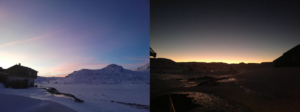
Figure 2: Stunning sunset in Finse, mid-January. ©Julia Wang
Accommodation & Living expenses
Overall, Norway is more expensive in nearly everything, which makes sense given their higher income. Usually, it is possible for exchange students to apply for student dorms (e.g. at Moholt). Those are particularly nice because of the large student communities that make it easy to meet new people. However, since I arrived in the winter semester – when most new local and exchange students come – the dorms were fully booked. As an internship student from Europe, I wasn’t automatically eligible for housing, so I had to request dorm accommodation. Even then, priority is typically given to international students from outside Europe and those attending summer courses at NTNU.
Thus, I ended up looking through the private housing market. Luckily, I found a room in a Norwegian student’s flatshare that was subletting for the exact duration of my stay. The flatshare with 4 people was comparably affordable and with 5300 NOK (everything included) even cheaper than the dorms. My place was located near Solsiden, which wasn’t exactly close to the university, but the area was well-connected by buses. It was also closer to the city center, as Tyholt and Moholt were about a 25-minute bus ride away. Personally, I preferred cycling since it is faster, cheaper, and the terrain was less steep compared to Gløshaugen-Moholt, which was a nice bonus.
As for the general living expenses, being a vegetarian made it a bit challenging to find affordable fresh vegetables, as everything tends to be more expensive and often heavily packaged in plastic. However, you get used to the prices after a while. As someone who loves tofu, I found it difficult to find good, firm Asian-style tofu. Common supermarket chains include Rema1000, Bunnpris, and Coop Mega for cheaper options, while Kiwi and Meny are more expensive. There are also online discounts and QR codes that offer discounts on specific products, and it’s helpful to ask around in ESN groups, as they often share these codes. I also found myself visiting Asian markets, like NM Market for the best deals on rice, soy sauce, and paneer at Melon Midtbyen. In general, products with higher fat, sugar, or imported goods were about twice as expensive as in Germany. However, Norwegians tend to offer larger packaging, which can help reduce the price per unit.
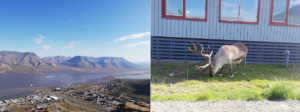
Figure 3: Parts of Longyearbyen and the Adventfjorden from the Varden viewpoint (left) and Svalbard reindeer in the middle of town (right). ©Julia Wang
Everyday life/the internship
Since I was doing my master thesis, my workload was higher compared to an average exchange student. I did miss out a bit on some activities since I was less flexible and had less free time. However, Norwegian work culture is much more chill and laid back than back in Germany. Nobody will ask you to come early and nobody cares if you leave early. Therefore, you need even more discipline to stay on track. Typical work hours in Norway are from 8am to 4pm. Afterwards, people head home for dinner. Many shops also close around 4 or 5 pm, so it’s a good idea to check their hours in advance to plan accordingly.
My thesis involved a field trip to Svalbard in mid-August, where I collected samples, spent time in the lab back In Trondheim, and then focused on writing the thesis. The working groups at NTNU are pretty small, so it is easy to get an overview but I rarely met everyone at once. Knowing how close people work together in working groups in Germany, sometimes I felt a bit lonely and disconnected from PhD or master students. However, I also enjoyed the independence I had to plan my own research, discuss it with my professor (who, by the way, dedicated a lot more time to me than the average professor in Germany would for a master’s student), and work closely with my supervisor. I also enjoyed the flexibility in how I structured my daily work and writing process.
In the evenings, I usually took part in various free-time activities including choir, anime screenings, board games, swimming, 3D printing, sewing, knitting, or baking. On weekends, I usually met up with friends, did my chores, or went on hikes and trips around the area. Sometimes, and further. With a bit of planning, you can easily bring your work with you, as many trains offer Wi-Fi! That way, you can explore places like Åndalsnes, Bergen, Finse (!!!), and more.
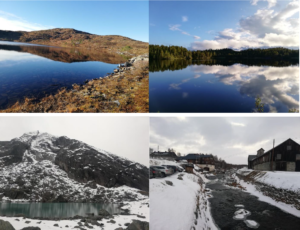
Figure 4: Stunning lakes and rivers found during hikes across Norway. Grytvatnet is found close to Vinjeøra, (upper left), Stordamvatnet is close to Lundamo (upper right), Hurrungsvatnet is near Åndalsnes (bottom left), and the Glomma river runs through Rørøs (bottom right). ©Julia Wang
Free time/tips
Trondheim is a big student city, so you will find all kinds of people. While connecting with international students was quite easy, since everyone is desperate to find friends, I was more interested stepping outside the Erasmus bubble and meeting Norwegians. And the stereotype holds true: While Norwegians are friendly and somehow open to start a conversation, there can still be a sense of distance. Personally, I’ve never been the most social or chatty person, so I always struggled to form deeper connections with anyone. That said, living with Norwegians and joining Norwegian clubs really helped me engage more with locals.
Norway is known for its stunning and beautiful nature (northern lights, midnight sun, mountains, fjords, lush green forests wherever you go!) and almost all Norwegians are big sports enthusiasts. NTNU has a student organization called NTNUI, where you can sign up for various sports clubs. Its very close to what American sports teams are like. People are competitive and passionate about their activities. If you want to try something typical Norwegian: You can join a group that teaches halling, a traditional Norwegian dance, or even take up sword fighting through another separate group.
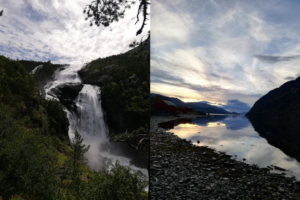
Figure 5: Because scenary with water is so beautiful: The stunning Nyastølfossen is found close to Kinsarvik on a 3-4 waterfall hike (left) and the beautiful sunset over Vinjefjorden can be observed in Vinjeøra (right). ©Julia Wang
If you are not into sports, there are still many student groups you can join: As for me, I joined a group called PVV for board games and anime. In general, they have a different focus but they also offer great social activities. I also joined a choir (NTNU motettkor), conducted by one of Norway’s most famous conductors and a group of Norwegian music students. The group was a fun mix of exchange students and locals, and the conductor was incredibly motivating, making it a truly enjoyable experience. Another popular hobby in Norway is knitting, with knitting events often hosted at cafés or yarn shops. It’s a relaxing activity, especially on those cold, rainy days. I also had the chance to learn 3D printing and practice sewing at the MakeNTNU workshop, where you can book time on a machine to create whatever you like (They are getting new printers, finally!!).
Another great place that offers cool events is the student building down the road from the technical university building: Studentersamfundet. It is definitely worth a visit, as they offer concerts, talk shows, discussions, I addition to having restaurants and more.
As for Trondheim, nature is incredibly accessible. You can enjoy small walks along the coast to the fjord in Lademoen, hikes in Estenstadmarka to the southeast, or head to Bymarka to the west. In winter, Bymarka is perfect for cross-country skiing. For bigger adventures, the ESN group organizes trips to Lofoten, Lapland, and other places. Otherwise, it is advisable to form small groups and rent a car to get around, especially in winter. While many people opt for Airbnbs, I highly recommend trying the great network of cabins in Norway! NTNUI Koiene have basic cabins around Trøndelag but personally, I suggest going for the DNT cabins as they are more spacious and comfortable.
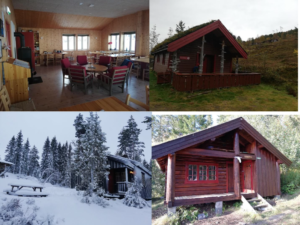
Figure 6: The common room in the DNT Brebua cabin in Finse (upper left), the DNT Venjedalsbu cabin close to Åndalsnes (upper right), a private cabin at Bymarka close to Ringvål (bottom left), and the Flåkoia NTNUI cabin near Lundamo (bottom right). ©Julia Wang
Conclusion
If you are an outdoor enthusiast who enjoys nature and want to experience a new culture during your internship or your thesis with excellent supervision and a nice work environment, I definitely recommend Norway. Not only did I gain insight into the country and its people, but I also embraced a new way of living my life while staying productive. There are plenty of opportunities and activities that allow you to connect with others. You just have to step out of your comfort zone and start engaging people!
I hope you enjoy your time here as much as I did if you choose Norway.
P.S. Yes, it does get pretty dark and depressing from November to February (Average daylight around 5h in Trondheim). But trust me, the experience alone is worth it. Plus, the midnight sun and longer days in summer make up for it!
Writing a Master Thesis in Milan
- Management and Engineering in Technology, Innovation, Marketing and
Entrepreneurship M.Sc. - Italy, Milan
- Politecnico di Milano
- March – June 2022
I am happy to share some insights on my time abroad in Milan, Italy. During that time, I conducted research on my Master thesis at Politecnico di Milano. I am solely responsible for the content of this report.
Preparation
Prior to applying for the Erasmus+ Internship grant, there are several steps to be taken independently from the country or city you will be studying at. In my case, didn’t do an internship but wrote my Master thesis at a foreign university. Therefore, preparation included looking for interesting institutes or researchers across Europe, who have expertise in a specific field you are interested in writing a thesis in. A decent approach is to search for relating papers or studies, for example. After you have set eyes on a specific institute, I suggest writing a short research proposal. This includes 5-10 pages where you are explaining your motivation and your expertise regarding the specific research topic. Additionally, I suggest you write a short introduction to a possible topic that seems suitable as Bachelor/ Master thesis. Once you are in contact with respective researchers at the institute you applied for, you can start looking for an internal supervisor at RWTH. The overall topic of the thesis can then be “finetuned” between the three parties. From my expertise (I also wrote my Bachelor thesis externally), it shouldn’t be a big problem to find an internal supervisor as long as the external institution seems interesting! The actual application for the Erasmus grant is quite self-explanatory and convenient, so no need to further explain it in this report.
There is not much to consider before moving to Milan, as it quite easy to move around the European Union. However, when living in Italy you need to register for an Italian tax number. Just contact the Consulate of Italy in Cologne before the movement and they will send you a respective number.
Living in Milan
Everyone who has been to Italy before, knows exactly the Italian kind of vibe. And even though Milan is in the northern part of Italy, the so-called business part, you can truly feel this Italian spirit in Milan. Enjoy the food and all the Aperitivos you will have during your time abroad! Milan truly offers a lot of great restaurants, bars, and cafes. But don’t fall into the tourist trap and rely too heavily on websites like TripAdvisor and Co. Rather try out Pizzeria Assaje for an amazing pizza! Because by doing so, it can easily get quite expensive without the food actually being delicious. Thus, I suggest walking around the streets and absorbing the atmosphere. I am quite certain that you will quickly find a great place to eat. Especially, the district Citta Studi where the PoliMi is located offers great localities. But the great part about Milan is its great variety of districts that all offer other specialties. Navigli, for example, is famous for its many bars and the two canals that are filled with tourists during the day. In contrast, Porta Venezia is known as gay district and also offers great bars including a lot of clubs, whereas Moscova is rather a more expensive area where the wordl famous Duomo is also located. Other than that, almost every day you can find a lot of people gathering on public places. The infamous, Piazza Leonardo right in the center of PoliMi offers a great atmosphere with hundreds of students gathering every weekend and some DJs playing some music. Milan as the creative and fashion capital of Italy offers lots of intellectual places. Fondazione di Prada or Pinacoteca di Brera displays great art and amazing architecture. Many museums offer student discounts. Pinacoteca di Brera, for example, just costs 2€ per person.
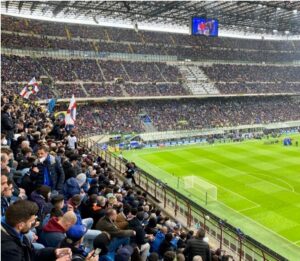
Picture from the stands of the San Siro stadium (Inter Milan vs AS Roma) © Jason Grüninger
Other than that, the San Siro stadium accommodates both Milanese teams AC Milan as well as Inter Milan. So, plenty of possibilities of embracing the incredible atmosphere in this stadium while watching first class football.
In summer, Italians are usually driving to the seaside themselves. You should do the same because Milan is quite empty in August! On a side note, as you are not included in any official welcome days by the host university, I suggest writing the RWTH authorities and asking them to share your contact details with the other moving students from RWTH. In this way, you already get to know some people before going abroad and can discuss common difficulties.
Accommodation/ Transport
For accommodation I recommend using Housing Anywhere. In Italy it is common that you don’t get to know your flat mates before you haven’t actually rent a room in the respective apartment. In my opinion that quite weird, but it is what it is. Just don’t be surprised! Another surprise can come with the prices for flats in the central districts. However, I suggest embracing the opportunity and really getting the most out of your time abroad by staying in the cool districts like Citta Studi, Porta Venezia, Washington, Moscova, Navigli. Otherwise, you might have to drive quite long distances, specifically because the metro stops working after 1pm and you have to use buses instead. Regarding the transportation, get yourself a monthly metro ticket. You just need a picture and then can file for the ticket at one of the ATM offices in the metro stations. The ticket costs 22€ per month and also allows you to take buses. Riding a bike in Milan is no fun because of cobblestones, bad streets, etc., so better use the public transport. Safety is not an issue in the public transport. Just be careful when taking the night buses, but no more caution is needed than anywhere else in big European cities.
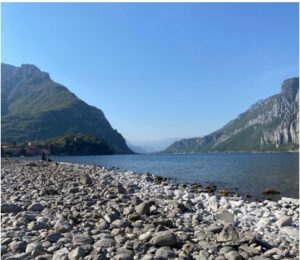
Lago di Como pictured in Lecco © Jason Grüninger
Around Milan
Milan is located in a great region. You are close to the mountains, as well as close to Lago di Como, Lago di Maggiore, and Lago di Garda. Enjoy some sun and take a dip at these destinations, it’s just an hour away from Milan by train!
Lecco, for example, is easy to reach and offers a cute little town at the stunning beginning of Lago di Como. I also went to Venice for two days, which is also quite close (3 hours by train).
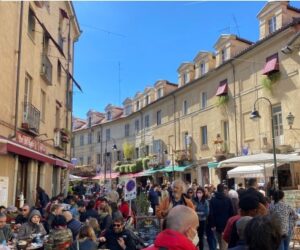
Busy street on a sunny day in Turin © Jason Grüninger
Additionally, Turin is close by and is definitely worth a visit! An absolutely underrated visit is the city of Bergamo. Especially the old town of Bergamo is beautiful and definitely worth a visit.
I hope this report gives you a good first impression of your time abroad.
I wish you a wonderful time in Milan!
